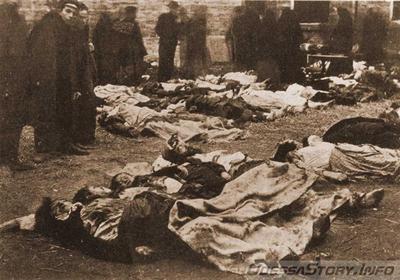
This image from Odessa (Ukrainian: Odesa) shows many Jewish victims of the violent pogrom wave that broke out after the promulgation of the 17 October Manifesto in 1905. The issuing of this document led to a counter-revolutionary response from what supporters saw as Russia’s true patriots and others evidenced as violent hooligan elements. Mostly, these occurred in different areas of what is now Ukraine, then home to the majority of Russia’s Jewish population. Traditionally pogroms were thought to be organized or condoned by the authorities. Successive waves of scholarship from the 1960s up to the present day challenged this view, as such sanctions were not found in Russia’s archives once they were opened. More widely, an antisemitic policy and culture made such actions possible. Persecution and harassment of Russia’s Jewish populations convinced anti-Semites in the Russian empire of the legitimacy of their violence, and evidence shows some minor and higher officials did have roles in fomenting attacks. Moreover, the government was apparently reluctant or unable to stop the pogroms and punish those responsible – recent research has pointed towards inertia and the under-governed nature of the Russian empire being key in allowing pogroms to spread, rather than a planned and sustained policy from the government.
Pogroms did not involve only members of the ‘radical right’, which did not anyway appear until well into 1905, but we should note the geographical proximity of many of the larger branches of the major right-wing parties and groups and earlier Russian pogroms. Not always easy to demonstrate, but likelihood is there was overlap in the demographics of those involved in both phenomena. This can also make us consider who is joining the Russian right, whether it reflected wider social currents/attitudes, and what elements of the group’s social bases might have been involved in violent phenomena.
Suggested Reading
Robert Weinberg, Blood on the Steppes: The Revolution of 1905 in Odessa (1992)
Inna Shtakser, The Making of Jewish Revolutionaries in the Pale of Settlement (2014)
Benjamin Nathans, Beyond the Pale. The Jewish Encounter with late Imperial Russia (2004)
Source commentary provided by:
Dr George Gilbert
Lecturer in Modern Russian History, Student Liaison and Communications
Email: G.Gilbert@soton.ac.uk